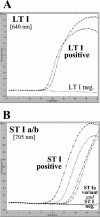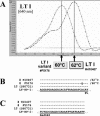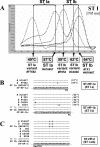Real-time fluorescence PCR assays for detection and characterization of heat-labile I and heat-stable I enterotoxin genes from enterotoxigenic Escherichia coli
- PMID: 15364995
- PMCID: PMC516355
- DOI: 10.1128/JCM.42.9.4092-4100.2004
Real-time fluorescence PCR assays for detection and characterization of heat-labile I and heat-stable I enterotoxin genes from enterotoxigenic Escherichia coli
Abstract
To facilitate the diagnosis of enterotoxigenic Escherichia coli (ETEC) infections in humans, we developed and evaluated real-time fluorescence PCR assays for the Roche LightCycler (LC) against the enterotoxin genes commonly present in strains associated with human illness. Separate LC-PCR assays with identical cycling conditions were designed for the type I heat-labile enterotoxin (LT I) and the type I heat-stable enterotoxin (ST I) genes, using the LC hybridization probe format. A duplex assay for ST I with two sets of amplification primers and three hybridization probes was required to detect the major nucleotide sequence variants of ST I, ST Ia and ST Ib. LC-PCR findings from the testing of 161 E. coli isolates of human origin (138 ETEC and 23 non-ETEC) were compared with those obtained by block cycler PCR analysis. The sensitivities and specificities of the LC-PCR assays were each 100% for the LT I and ST I genes. The LC-PCR and block cycler PCR assays were also compared for their abilities to detect LT I and ST I genes in spiked stool specimens with different methods of sample preparation. Findings from these experiments revealed that the limits of detection for the LC-PCR assays were the same or substantially lower than those observed for the block cycler PCR assay. Melting curve analysis of the amplified LT I and ST I genes revealed sequence variation within each gene, which for the ST I genes correlated with the presence of ST Ia and ST Ib. The rapidity, sensitivity, and specificity of the LC-PCR assays make them attractive alternatives to block cycler PCR assays for the detection and characterization of ETEC.
Figures



Similar articles
-
Rapid detection of diarrheagenic E. coli by real-time PCR.J Microbiol Methods. 2005 Jun;61(3):335-41. doi: 10.1016/j.mimet.2004.12.007. Epub 2005 Jan 11. J Microbiol Methods. 2005. PMID: 15767009
-
Real-Time TaqMan PCR Assay for the Detection of Heat-Labile and Heat-Stable Enterotoxin Genes in a Geographically Diverse Collection of Enterotoxigenic Escherichia coli Strains and Stool Specimens.Foodborne Pathog Dis. 2016 Apr;13(4):212-20. doi: 10.1089/fpd.2015.2064. Epub 2016 Feb 9. Foodborne Pathog Dis. 2016. PMID: 26859628
-
Rapid and sensitive detection of heat-labile I and heat-stable I enterotoxin genes of enterotoxigenic Escherichia coli by Loop-Mediated Isothermal Amplification.J Microbiol Methods. 2007 Feb;68(2):414-20. doi: 10.1016/j.mimet.2006.09.024. Epub 2006 Nov 13. J Microbiol Methods. 2007. PMID: 17098313
-
Development and use of a multiplex PCR system for the rapid screening of heat labile toxin I, heat stable toxin II and shiga-like toxin I and II genes of Escherichia coli in water.J Appl Microbiol. 1998 Apr;84(4):585-92. doi: 10.1046/j.1365-2672.1998.00385.x. J Appl Microbiol. 1998. PMID: 9633656
-
Enterotoxigenic Escherichia coli in a population of infants with diarrhea in Chile.J Clin Microbiol. 1985 Oct;22(4):576-81. doi: 10.1128/jcm.22.4.576-581.1985. J Clin Microbiol. 1985. PMID: 3908470 Free PMC article.
Cited by
-
Escherichia coli K88ac fimbriae expressing heat-labile and heat-stable (STa) toxin epitopes elicit antibodies that neutralize cholera toxin and STa toxin and inhibit adherence of K88ac fimbrial E. coli.Clin Vaccine Immunol. 2010 Dec;17(12):1859-67. doi: 10.1128/CVI.00251-10. Epub 2010 Oct 27. Clin Vaccine Immunol. 2010. PMID: 20980482 Free PMC article.
-
Enteroaggregative Escherichia coli O78:H10, the cause of an outbreak of urinary tract infection.J Clin Microbiol. 2012 Nov;50(11):3703-11. doi: 10.1128/JCM.01909-12. Epub 2012 Sep 12. J Clin Microbiol. 2012. PMID: 22972830 Free PMC article.
-
Co-detection of virulent Escherichia coli genes in surface water sources.PLoS One. 2015 Feb 6;10(2):e0116808. doi: 10.1371/journal.pone.0116808. eCollection 2015. PLoS One. 2015. PMID: 25659126 Free PMC article.
-
Comparison between O serotyping method and multiplex real-time PCR to identify diarrheagenic Escherichia coli in Taiwan.J Clin Microbiol. 2007 Nov;45(11):3620-5. doi: 10.1128/JCM.00596-07. Epub 2007 Aug 29. J Clin Microbiol. 2007. PMID: 17728475 Free PMC article.
-
Involvement of quorum sensing and heat-stable enterotoxin a in cell damage caused by a porcine enterotoxigenic Escherichia coli strain.Infect Immun. 2011 Apr;79(4):1688-95. doi: 10.1128/IAI.01281-10. Epub 2011 Feb 7. Infect Immun. 2011. PMID: 21300771 Free PMC article.
References
-
- Black, R.E. 1986. The epidemiology of cholera and enterotoxigenic Escherichia coli diarrheal disease, p. 23-32. In J. Holmgren, A. Lindberg, and R. Mollby (ed.), Development of vaccine and drug against diarrhea. Eleventh Nobel Conference, Stockholm. Studentlitteratur, Lund, Sweden.
-
- Centers for Disease Control and Prevention. 1994. Foodborne outbreaks of enterotoxigenic Escherichia coli—Rhode Island and New Hampshire. Morb. Mortal. Wkly. Rep. 43:81-89. - PubMed
Publication types
MeSH terms
Substances
LinkOut - more resources
Full Text Sources
Other Literature Sources
Molecular Biology Databases

